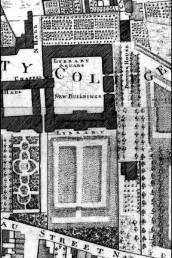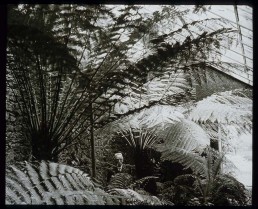Trinity College Botanic Garden is one of the earliest established botanic gardens in the UK and Ireland and the only dedicated university botanic garden on the island of Ireland.
The Physic Garden
Trinity College Botanic Garden came into being as a physic garden over 330 years ago to provide plant material for the teaching of medicine at Trinity College. Less than a decade later the garden had become derelict, and was partly used as a dumping ground for the Anatomy Department! In 1711, the first Lecturer in Botany was installed and set about reinstating it. In his booklet The Story of the Botanic Gardens of Trinity College 1687 to 1987, Dr Peter Wyse Jackson presents a fascinating account of those early years in the garden’s establishment:
“A Royal charter was obtained on 3 March 1592 and so Trinity College came into being as “the College of the Holy and Undivided Trinity near Dublin” (McDowell & Webb, 1982). Almost 100 years later on 25 June 1687 the Board of the College made a decision to found a Physic Garden on the site of the College kitchen garden. Despite the occupation of the College by Jacobite troops in 1689, during the War of English Succession, the garden survived. However, there is no record of which plants were grown, or indeed where the garden was situated, within the College campus at that time.
“In 1711 Thomas Molyneux, a graduate of Leiden, became Professor of Physic in the College. He arranged for an anatomy theatre and laboratory to be built and he employed a lecturer to teach botany. The lecturer engaged was Dr Henry Nicholson, a native of Co. Roscommon and another graduate of Leiden (Nelson, 1982). He undertook the replanting of the Physic Garden and expanded its plant collections. His work is recorded in a booklet about the arrangement of the plants in the Garden (Nicholson, 1712). Nicholson did not remain for long in the College and left Dublin in 1715. It appears that no successor was appointed until 1724 when another graduate of Leiden, Dr William Stephens, took over (Nelson, 1982). In the meantime the first Physic Garden had been abandoned in 1723 and a new one was created in an area which is now largely covered by the Berkeley Library. No plants that were grown in this Garden have survived and there is no trace of any trees that may have been planted in that time in the area now.”
“In 1773 Dr Edward Hill was appointed Professor of Botany, by which time the Physic Garden had become very run-down. According to Hill it contained a single barren fig tree tended by an ancient gardener with the whole Garden overshadowed by tall elms. As well as that, the offal from the Anatomy Laboratory nearby was thrown out into the Garden where is was said to be devoured by 10,000 rats! Hill decided to abandon the Physic Garden and began to campaign for the establishment of a new Garden (Nelson & McCracken, 1987).”
There was an attempt to establish a garden in Harold’s Cross to the south west of the campus, but this was short-lived. Efforts were then made to revive the Physic Garden, which still remained, but, even for a skilled horticulturist like James Townsend Mackay appointed as gardener in 1804, it proved unsuitable and was abandoned.
In 1806, the College leased eight acres of land in Ballsbridge where a botanic garden was established.
The Ballsbridge Garden
In 1804 a new assistant botanist, James Townsend Mackay, was appointed to teach Irish Botany to medical and other Trinity College students, and a switch to pure botany began. Since the old Physic Garden proved unsuitable for a botanic garden, space was found on an eight-acre site newly leased by the College at Ballsbridge. Wyse Jackson describes a resurgence of enthusiasm and investment in the new garden:
“…about 3 acres of ground were taken from this plot for the Botanic Garden and enclosed within a 10-foot wall in the autumn of 1807. Then in the spring of 1808 the planting of trees, shrubs and herbaceous plants began. Shortly afterwards a portion of this area was laid out with a collection of medicinal plants under the direction of Professor W. Allman, then Professor of Botany in the University. In 1832 an additional 2 acres were added to the Garden at its south-western side and enclosed by an iron railing, some of which still survives today. This area was laid out with a collection of trees. In 1848 the final addition to the Garden was made, with a further one and a half acres at the north-western corner, around which the iron railings were continued. This area was enclosed to act as a screen for the main part of the Garden from the surrounding buildings and from smoke pollution. A screen of holm oaks (Quercus ilex L.) was later planted along this boundary, most of which still survive as a fine row of mature trees.
“Several large greenhouses were erected in the Garden in the early years including a large wooden stove house. This greenhouse was demolished during the 1960s. A very wide range and variety of species was grown, and in 1851 Mackay notes that the Garden had extensive collections of orchids, ferns, palms, cacti (including a collection sent by Thomas Coulter from Mexico), Proteaceae and others.”
Over the next one hundred years this garden developed considerably and held an important and varied collection of plants. Notable curators of the garden at this time include J. T. Mackay, credited with producing the first flora of Ireland – Flora Hibernica – in 1836, and F. W. Burbidge, who was widely known for his exploration of the Kinabalu region of what is now Sabah in the north of Borneo, and for his work on the collection and hybridisation of Narcissus.
The College Tercentenary in 1892 was celebrated at the Garden with the presentation of a massive specimen of the tree fern Todea barbara, a gift from Baron Ferdinand von Muller, Curator of the Royal Botanic Garden, Melbourne:
“The plant was very large when collected and was 3000 lbs in weight. It was shipped to Dublin in a large case made of eucalyptus timber. Muller believed that this fern had probably “begun its career from a spore about the time when the University of Dublin was founded” in 1692 (Morley, 1970; Nelson, 1978).”
When the garden later moved from Ballsbridge to its present site in Dartry the fern was presented by the College to Glasnevin Botanic Gardens in 1969. Before it was handed over a cutting was taken and this still thrives in the Dartry garden.
After the death of Burbidge in 1905 the position of Curator was abandoned. As a result, the garden “suffered from this lack of scientific curation and ceased to develop.” This was partly redressed when David A. Webb became Professor of Botany in 1950 and saw to the appointment of an assistant curator, Miss May Crosbie, in 1951. She was succeeded by Miss Joan O’Mara in 1963, who continued on the curatorial work through the last years of the Ballsbridge garden, and into the establishment of the current Botanic Garden in Dartry.
Dr A.F.G. Kerr was a medical graduate of Trinity College and a keen botanist. He was the first and remains the most important collector of plants from the tropical forests of Thailand. Kerr donated a large number of specimens and some photographs to the herbarium. He is pictured here beside the pond in the Ballsbridge garden, circa. 1940s.
The Garden at Dartry
In 1965 a plan was put before the College Board to relocate the garden from Ballsbridge to Trinity Hall, a student accommodation complex in Dartry. This move was approved, giving the garden better long-term security as the Trinity Hall site is freehold. The move was completed over 1966 and 1967; a large hotel complex now stands on the former Ballsbridge garden site. Many important plant specimens were transferred to Dartry, including a 25-foot-tall Ginkgo biloba and various cycads.
Development of the ‘new’ botanic garden proceeded steadily. An important development came with the creation of a position of Administrator in 1981 (now Curator/Administrator). The garden established an international reputation for plant conservation work and supported a diversity of research projects ranging from low temperature tolerance to the effects of elevated carbon dioxide on growth of grasses. To commemorate the College quatercentenary in 1992, the garden was presented with the gift of another tree fern by the Royal Botanic Garden Sydney: a fine specimen of Cyathea australis from Australia.
The extracts above taken are taken from an edited version of The Story of the Botanic Gardens of Trinity College 1687 to 1987 by Peter Wyse Jackson, published as ‘The Botanic Garden of Trinity College Dublin 1687 to 1987’ in the Botanical Journal of the Linnean Society (1987), vol 95 pp 301-311.
Prof. Jennifer McElwain

Directors Appointed
- Henry H. Dixon 1905
- David A. Webb 1950
- William A. Watts 1966*
- David H.S. Richardson 1980
- David W. Jeffrey 1992
- Mike B. Jones 2002
- John A.N. Parnell 2005
- Jennifer C. McElwain 2019
* During some of the period up to 1980, D.W. Jeffrey was appointed Acting-Director
Curators Appointed
- James Townsend Mackay 1802
- John Bain 1862
- Michael Dowd 1875
- Frederick Moore 1877
- Frederick W. Burbidge 1879-1905
- Peter S. Wyse Jackson 1981**
- Stephen Waldren 1990
After Burbidge’s death in 1905 the garden was without a Curator until 1951, when an Assistant Curator post was established which was held by two women,
- May Crosbie 1951
- Joan O’Mara 1963-1979
Until then the garden was managed by the Head Gardener (S.G. Wild, 1905; Robert Byrne, 1949; and Denis McKennedy, 1960)
** Curator post re-established as Garden Administrator in 1981, and Curator/Administrator from 1994
[All historical images reproduced courtesy of the Board of Trinity College Dublin from a presentation on the history of Botany for the 2011 Tercentenary Celebrations by Dr James White.]
The Garden Today
Today, the garden supports Trinity College Botany Department’s teaching in conservation biology, taxonomy, physiological ecology, pollination biology and plant response to climate change. It provides living plant material, controlled growth environments, glasshouses and other experimental facilities for botanical research. The garden also houses the Irish Threatened Plant Seedbank, circa 4000 species in the living collections, four heated glasshouses, three unheated glasshouses, walk-in controlled environment chambers, low temperature growth facilities, experimental plots including open top chambers, growing beds including systematic garden and arboretum, potting shed and ancillary facilities. Zoological facilities including research mesocosms and a bird house are also located within the gardens.
Read about our exciting ten-year strategy for the gardens (2020 – 2030) here.
You can also learn more about the long history of Botany at Trinity College at https://www.tcd.ie/Botany/tercentenary/













